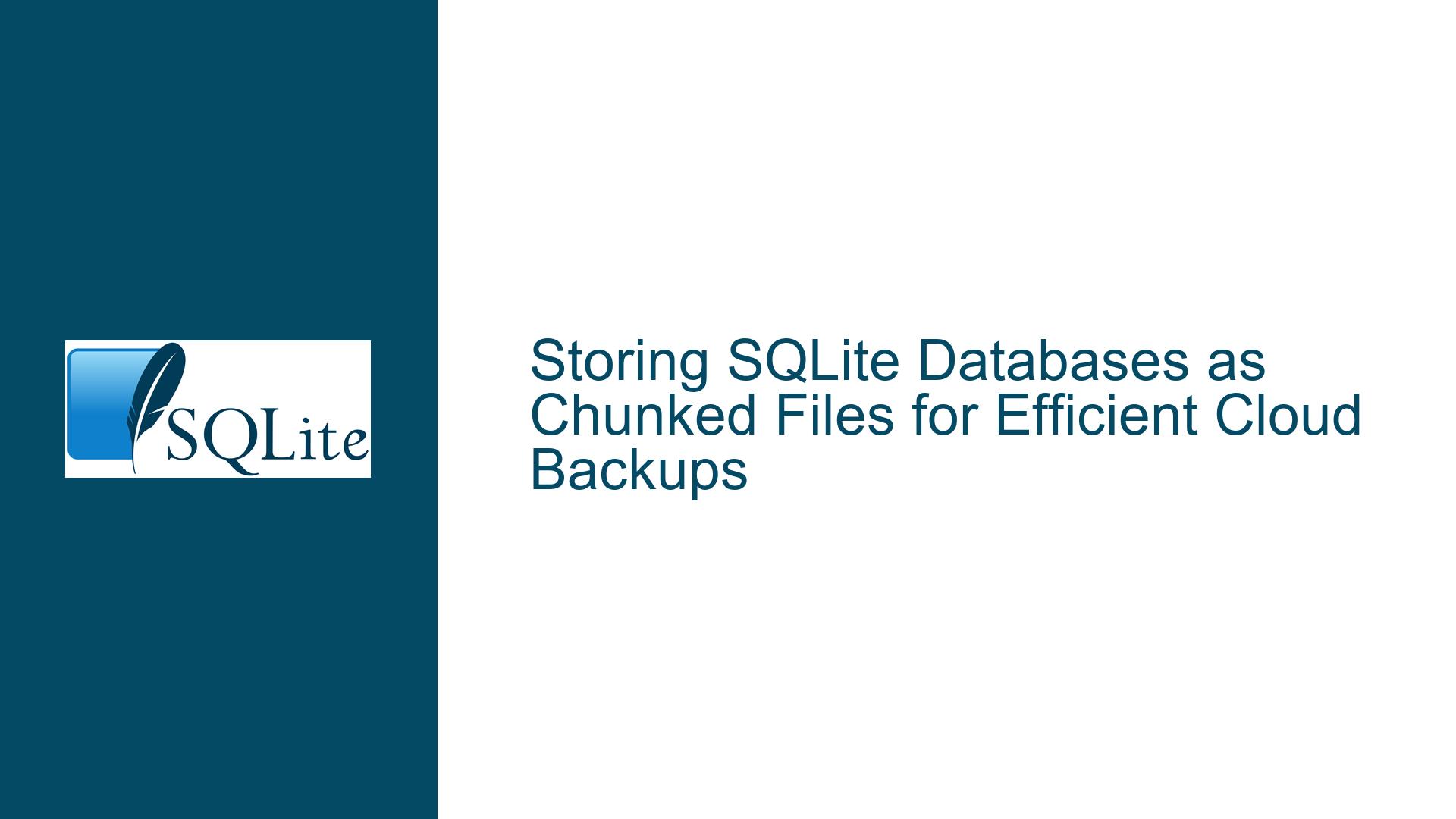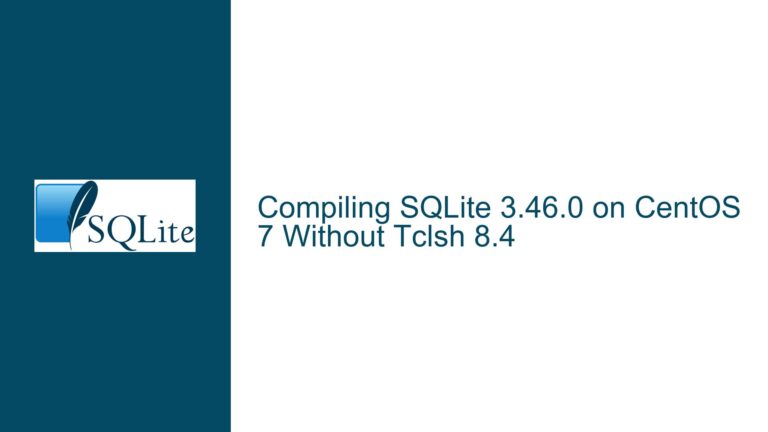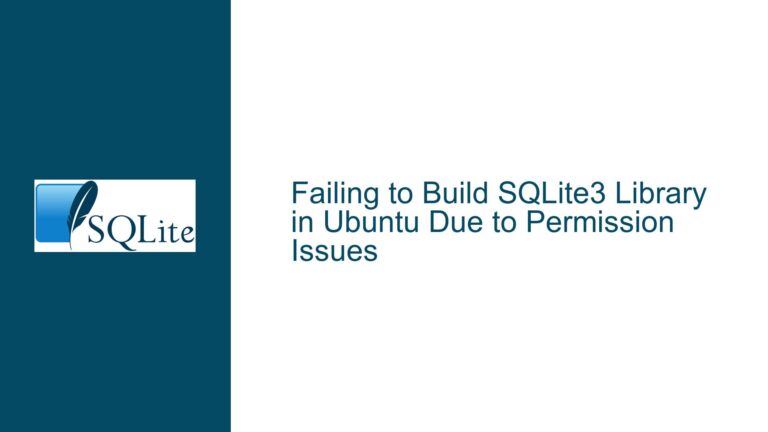Storing SQLite Databases as Chunked Files for Efficient Cloud Backups
Understanding the Challenge of Splitting SQLite Databases into Fixed-Size Chunks
The core technical challenge involves splitting a SQLite database into multiple fixed-size files (e.g., 512 KB chunks) to enable incremental cloud backups. Cloud object storage systems like Amazon S3, Google Cloud Storage, or Azure Blob Storage do not support efficient partial file updates. When a SQLite database is stored as a single monolithic file, even minor modifications (e.g., inserting a row or updating an index) require rewriting the entire file to the cloud. This creates significant overhead in bandwidth, storage costs, and backup latency.
SQLite’s architecture assumes a single database file, with all transactions and I/O operations coordinated through its Virtual File System (VFS) layer. The default VFS implementation interacts with the host operating system’s file APIs to read/write contiguous bytes within a single file. To split the database into chunks, the VFS layer must be modified to transparently manage multiple files as if they were a single logical storage unit. This requires intercepting file operations such as xRead, xWrite, and xFileSize and mapping them to the appropriate chunk files.
Key technical constraints include maintaining ACID (Atomicity, Consistency, Isolation, Durability) guarantees across chunk boundaries, ensuring transactional integrity when chunks are modified concurrently, and handling edge cases such as chunk overflow during write operations. For example, if a write operation causes a chunk to exceed the 512 KB limit, the VFS must automatically create a new chunk and redirect subsequent writes without disrupting active transactions.
Architectural and Operational Constraints Leading to Chunking Complexity
The need for chunked SQLite databases arises from fundamental mismatches between SQLite’s storage model and cloud object storage capabilities. Below are the primary factors complicating this approach:
1. Cloud Storage Limitations in Partial Updates
Cloud object stores like S3 are optimized for immutable objects. The "PUT" operation replaces an entire object, making incremental updates impractical. While some providers offer append-only operations or multi-part uploads, these are not universally supported and often lack atomicity. For instance, appending data to an existing S3 object requires re-uploading the entire modified chunk, negating the efficiency gains of chunking.
2. SQLite’s Write-Ahead Log (WAL) and Page-Oriented I/O
SQLite operates on fixed-size pages (default: 4 KB). The WAL mechanism journals changes in a separate file before committing them to the main database. When using WAL mode, modifications are initially written to the WAL file and later transferred to the main database during checkpointing. Splitting the WAL file into chunks would require tracking both the main database and WAL across multiple files, complicating crash recovery and consistency checks.
3. VFS Layer Abstraction Limits
The VFS layer abstracts file operations but assumes a single file handle per database. A chunked VFS must manage multiple file handles dynamically, introducing challenges in handle lifecycle management (opening/closing chunks on demand) and ensuring thread safety. For example, concurrent transactions might attempt to write to the same chunk, requiring locking mechanisms to prevent corruption.
4. Chunk Metadata Management
To reassemble chunks into a coherent database, the VFS must track metadata such as chunk order, size, and modification timestamps. Storing this metadata externally (e.g., in a separate manifest file) introduces a single point of failure. If the manifest is lost or corrupted, the entire database becomes unreadable.
5. Performance Overhead from Chunk Proliferation
Frequent chunk creation increases the number of files managed by the VFS, potentially degrading performance due to filesystem inefficiencies (e.g., inode exhaustion, directory traversal latency). This is exacerbated in environments with limited file descriptors or slow storage media.
Implementing and Optimizing a Chunked SQLite VFS for Cloud Backups
Step 1: Evaluate Existing Solutions and Alternatives
Before developing a custom VFS, explore existing tools and SQLite features that might mitigate the problem:
- SQLite’s Multiplexor Extension: The
test_multiplex.cfile referenced in the forum discussion provides a prototype for a multiplexed VFS that spreads data across multiple files. However, this code is part of SQLite’s test suite and not production-grade. It demonstrates how to override VFS methods likexReadandxWritebut lacks error handling, chunk size management, and cloud integration. - Delta Synchronization Tools: Tools like
rsync,rclone, or cloud-native solutions (e.g., AWS Backup) can reduce bandwidth by transferring only modified portions of the database file. However, these tools operate at the filesystem level and cannot leverage SQLite’s page structure for granular diffs. - SQLite Archive Mode: The
.archivecommand generates compressed backups but does not support incremental updates.
Step 2: Design a Custom Chunked VFS
A robust chunked VFS requires the following components:
Chunk Size Configuration
Define a maximum chunk size (e.g., 512 KB). The VFS will create new chunks when writes exceed this limit. Chunk numbering can be sequential (e.g.,db_0001,db_0002) or hash-based.File Handle Management
Maintain a cache of open chunk file handles to avoid frequent open/close operations. Use LRU (Least Recently Used) eviction to prevent exceeding OS file descriptor limits.Read/Write Redirection
Override thexReadandxWritemethods to calculate the target chunk and offset. For example, a write to byte offset1,000,000in a 512 KB chunk system would target chunk 2 (bytes 0–524,287 in chunk 1, 524,288–1,048,575 in chunk 2).Atomic Commit Handling
Ensure that transactions spanning multiple chunks are atomic. Use a manifest file to track active chunks and employ a two-phase commit protocol:- Phase 1: Write all modified chunks to temporary files.
- Phase 2: Atomically rename temporary files to final chunks and update the manifest.
Recovery and Consistency Checks
Implement axCheckReservedLockmethod to prevent corruption during concurrent access. Include checksums (e.g., CRC32) in each chunk to detect data corruption.
Step 3: Integrate with Cloud Storage
After implementing the chunked VFS, optimize cloud backups:
- Incremental Uploads: Track modified chunks using their last-modified timestamps or a watermark. Upload only changed chunks after each transaction.
- Atomic Manifest Updates: Use cloud storage’s versioning or conditional PUT operations to ensure the manifest file reflects the latest consistent state.
- Chunk Garbage Collection: Periodically delete orphaned chunks (e.g., from aborted transactions) using reference counting in the manifest.
Step 4: Performance Tuning and Testing
- Benchmark Chunked vs. Single-File Performance: Measure the impact of chunking on read/write throughput, especially for large transactions.
- Stress Test Edge Cases: Simulate scenarios like chunk overflow during a write, network failures during upload, and concurrent access from multiple processes.
- Optimize Chunk Size: Balance smaller chunks (finer backup granularity) against increased metadata overhead.
Step 5: Fallback Strategies and Alternatives
If developing a custom VFS is impractical, consider these alternatives:
- Database Sharding: Split data into multiple SQLite databases (e.g., by date or user) and back up each individually.
- Hybrid Backup Systems: Use WAL mode with frequent checkpointing and back up the WAL file separately.
- Block-Level Storage Gateways: Deploy a cloud gateway that presents block-level storage (e.g., AWS Storage Gateway) to SQLite, enabling incremental backups at the block level.
By systematically addressing these technical hurdles, developers can achieve efficient cloud backups for SQLite databases while maintaining compatibility with existing applications.






